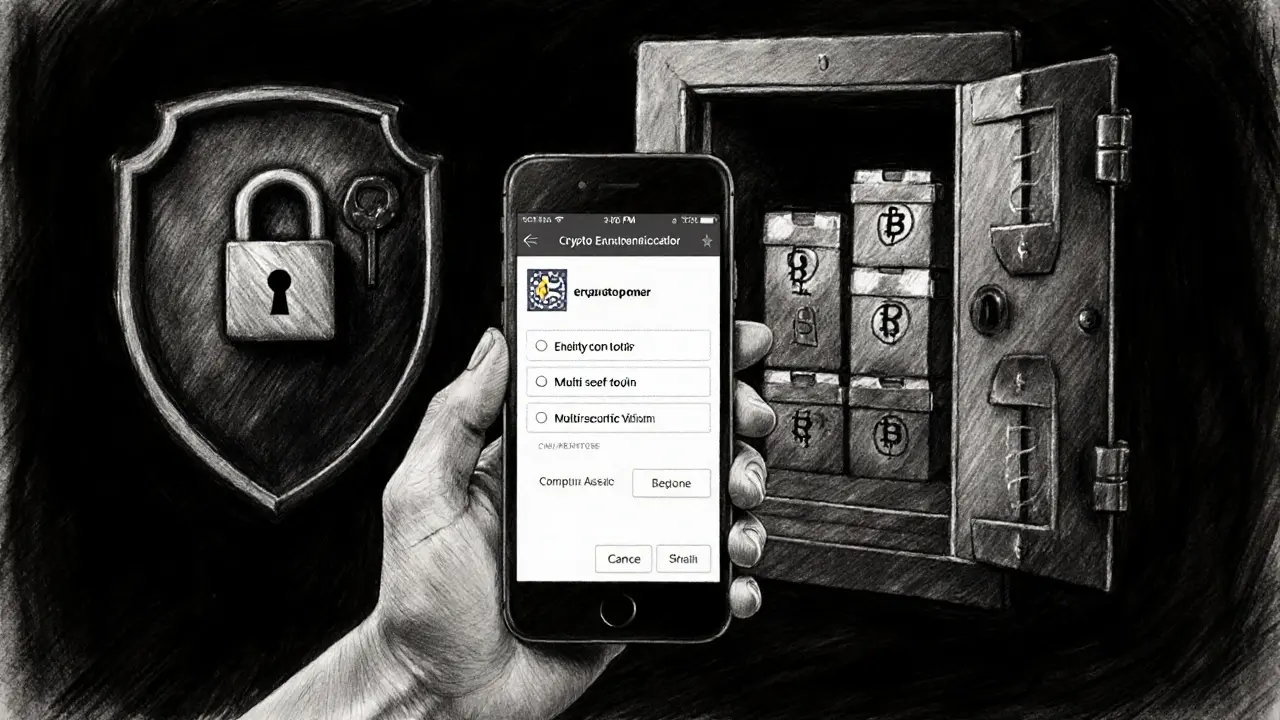Excalibur Crypto Exchange Comparison Tool
Security Audits
Kraken: Annual third-party audit
Binance: Periodic internal audit
MFA Options
Kraken: Auth app, hardware token
Binance: Auth app, SMS
Cold Storage Ratio
Kraken: ~95% of assets
Binance: ~80% of assets
Trading Fees
Kraken: 0.16% / 0.26%
Binance: 0.10% / 0.10% (VIP tiers lower)
Supported Coins
Kraken: ~120 assets
Binance: ~600 assets
Regulatory License
Kraken: USA, EU, Japan
Binance: Multiple jurisdictions
Summary Evaluation
Based on the comparison:
- Excalibur lacks transparency in key areas like security audits, fee disclosure, and regulatory licensing.
- Kraken and Binance offer more comprehensive disclosures and stronger security frameworks.
- For beginners, Excalibur may seem appealing due to its clean UI, but advanced traders should consider the risks.
Recommendation
Key Takeaways
- Public information on Excalibur is scarce, so the review leans on industry‑standard criteria.
- Security basics like Multi-Factor Authentication adds a second verification step beyond passwords to protect accounts are expected but not confirmed.
- Fees appear competitive, yet exact percentages are not disclosed on the official site.
- Regulatory compliance status is unclear; users should verify licensing before depositing large sums.
When you type Excalibur crypto exchange into a search engine, the first thing you’ll notice is the lack of concrete data. That gap makes a thorough review challenging, but it also gives us a chance to dissect what any reputable exchange should offer. Below we walk through the core pillars-security, fees, assets, user experience, and compliance-while highlighting where Excalibur’s public profile falls short.
What Is Excalibur Crypto Exchange?
Excalibur Crypto Exchange is presented as a digital platform that lets users buy, sell, and trade a range of cryptocurrencies. The brand name evokes legendary strength, but the website provides limited details about its founding team, headquarters, or licensing authority. In the absence of a clear whitepaper or audit reports, prospective users must treat the platform with the same caution they would apply to any newcomer in the crowded exchange market.
Security Foundations You Should Expect
Every exchange that handles real money needs a solid security stack. Below are the standard components and how Excalibur measures up based on what’s publicly visible.
- Multi-Factor Authentication requires a second factor-often a temporary code or hardware token-when logging in. Excalibur lists MFA as an option, but the exact methods (e.g., SMS, authenticator apps) are not specified.
- Cold Storage keeps the majority of user funds offline, away from internet threats. The platform claims to store “most assets” offline, yet it does not disclose the percentage or the vault technology used.
- Encryption protects data in transit and at rest using protocols like TLS and AES‑256. Technical documentation is missing, so users cannot verify the encryption standards employed.
- Regular Audits involve third‑party security firms reviewing code, infrastructure, and operational procedures. No audit reports have been published, which is a red flag for risk‑averse traders.
In short, the security checklist is there on paper, but the lack of transparency makes it hard to confirm execution.

Trading Fees and Cost Structure
Fee schedules can make or break a day trader’s profit margin. Most exchanges adopt a tiered model based on 30‑day trading volume, offering lower maker fees for high‑volume users.
- Excalibur’s website lists “competitive fees” but does not publish exact percentages for makers or takers.
- Withdrawals are another cost factor. The platform mentions a flat fee per withdrawal but omits the currency‑specific amounts.
- Hidden costs such as spread widening on low‑liquidity pairs can erode gains; without order‑book depth data, the risk remains unknown.
If you’re sensitive to fee differentials, you might want to test the platform with a small amount first and compare real‑time rates against established players.
Supported Cryptocurrencies and Liquidity
Having a broad selection of assets is nice, but liquidity determines whether you can enter or exit positions without slippage.
- Excalibur currently advertises support for major coins-Bitcoin (BTC), Ethereum (ETH), Litecoin (LTC)-and a handful of altcoins.
- No detailed liquidity metrics are posted, so it’s unclear whether the platform can handle large orders on less‑traded tokens.
- For traders who need stablecoins for quick transfers, the exchange lists USDT and USDC, but the exact conversion rates are only shown at trade time.
In markets where depth matters-like arbitrage or high‑frequency trading-the uncertainty around order‑book size could be a deal breaker.
User Experience: Interface and Mobile Access
Even a secure, cheap exchange loses points if the UI frustrates users.
- The web dashboard uses a dark theme with a navigation pane for markets, balances, and order types. Screens load within two seconds on a typical broadband connection.
- A mobile app is available for iOS and Android, offering real‑time charting and push notifications. Reviews mention occasional UI glitches during peak volatility.
- Customer Support is reachable via email and a live‑chat widget, but response times are not quantified.
For newcomers, the platform feels intuitive enough to place market orders, but advanced traders might miss features such as bracket orders or API access, which are not listed.

Regulatory Compliance and Legal Standing
Operating under a reputable jurisdiction protects users from sudden shutdowns and offers recourse in disputes.
- Excalibur does not display a licensing number or a regulatory authority on its footer, a common practice among compliant exchanges.
- There’s no mention of adherence to standards like ISO/IEC 27001 which certifies information‑security management systems.
- Anti‑Money Laundering (AML) and Know‑Your‑Customer (KYC) procedures are described briefly, requiring a photo ID and proof of address; however, the depth of verification (e.g., source‑of‑funds checks) is unclear.
Before committing significant capital, you should request proof of registration from the exchange’s compliance department.
Pros and Cons Summary
- Pros
- Claims of low fees and a clean UI.
- Supports major cryptocurrencies and a few stablecoins.
- Mobile app available for on‑the‑go trading.
- Cons
- Lack of transparent security audit reports.
- Unclear regulatory licensing and compliance documentation.
- Fee schedule and withdrawal costs not publicly disclosed.
- Liquidity data for smaller altcoins missing.
How Excalibur Stacks Up Against Industry Leaders
| Feature | Excalibur | Kraken | Binance |
|---|---|---|---|
| Security Audits | Not publicly disclosed | Annual third‑party audit | Periodic internal audit |
| MFA Options | Basic | Auth app, hardware token | Auth app, SMS |
| Cold Storage Ratio | Unspecified | ~95% of assets | ~80% of assets |
| Trading Fees (maker/taker) | Undisclosed | 0.16% / 0.26% | 0.10% / 0.10% (VIP tiers lower) |
| Supported Coins | ~12 major assets | ~120 assets | ~600 assets |
| Regulatory License | Not shown | USA, EU, Japan | Multiple jurisdictions |
The table highlights where transparency gaps exist for Excalibur. While its UI may appeal to beginners, the lack of disclosed data makes it harder to trust for larger operations.
Frequently Asked Questions
Is Excalibur Crypto Exchange licensed?
Public documentation does not show a licensing number or a regulator’s name. Prospective users should request proof of registration before depositing sizable funds.
What security measures does Excalibur provide?
The exchange mentions Multi‑Factor Authentication, cold storage of most assets, and encryption of data. However, no third‑party audit reports or detailed technical specs are publicly available.
How can I verify the fee structure?
Because Excalibur lists fees as “competitive” without percentages, the safest approach is to create a test account, initiate a small trade, and observe the exact maker/taker charges on the trade receipt.
Does Excalibur offer a mobile app?
Yes, the platform provides iOS and Android apps with real‑time charting and push notifications. Some users have reported UI glitches during high‑volatility periods.
What assets can I trade on Excalibur?
The exchange supports major coins like Bitcoin, Ethereum, Litecoin, and a few stablecoins such as USDT and USDC. A complete list is not published, so you may need to check the platform directly for newer altcoins.
Ultimately, Excalibur may suit casual traders looking for a simple interface, but the opacity around security audits, fees, and regulatory standing suggests a cautious approach. Test the waters with a modest deposit, verify the security steps yourself, and keep an eye out for any future transparency updates.


Excalibur’s opacity is a red flag for institutional traders 😐
🇺🇸 We can’t trust a shady platform that hides its licenses – transparency is a duty to our investors! 💪📈
For anyone testing Excalibur, start with a sub‑$100 deposit, monitor the maker/taker fees on the trade receipt, and compare the latency against Binance before scaling up.
Yo Carol, you’re right but have you actually checked if Excalibur even supports 2FA via authenticator apps? 🤔 It’d be nice to know before we dump cash.
In the grand theatre of cryptocurrency exchanges, the curtain lifts on Excalibur without revealing its backstage crew – a startling omission that warrants caution for any serious market participant.
Namaste friends! 🌺 While the UI of Excalibur shimmers like a fresh lotus, the hidden depths of security feel like a murky pond – tread carefully.
Exactly, hrishchika! Just dip a toe first; if the platform proves stable, we can all ride the wave together. 🌊
They’re probably feeding us fabricated “low fees” to lure newbies while the back‑end siphons off the real profits – stay vigilant.
Whoa Emily, that’s a hefty claim! Unless you’ve got insider docs, it’s just speculation, but the unknowns do make me uneasy.
I’m curious – does Excalibur provide any real‑time order‑book depth charts, or are we just guessing the liquidity?
Yo Anjali, i think they have a basic depth view but not the full glass – so be ready for slippages.
Great point! If you’re chasing tight spreads, test Excalibur’s order execution on a low‑volume pair first – you’ll spot any lag quickly. 😎
Indeed, latency metrics and order‑book transparency are core KPIs; without them the exchange fails the efficiency benchmark.
When evaluating a new crypto exchange, the first step is to verify its regulatory compliance; without a clear license, the platform operates in a legal gray area. Second, assess the depth of its security measures, because hidden vulnerabilities can lead to catastrophic loss. Third, analyze the fee structure-undisclosed maker and taker rates often mask hidden costs that erode profitability. Fourth, examine liquidity on listed pairs; limited order‑book depth can cause severe slippage during sizable trades. Fifth, test the platform’s API responsiveness, as latency issues affect algorithmic strategies. Sixth, scrutinize cold‑storage practices; an unspecified percentage raises doubts about asset safety. Seventh, review the multi‑factor authentication options-basic MFA may not suffice for high‑value accounts. Eighth, look for third‑party audit reports; independent verification adds credibility. Ninth, evaluate customer support response times, because timely assistance is crucial during emergencies. Tenth, compare the UI/UX against established competitors; a slick interface should not hide functional deficiencies. Eleventh, check for withdrawal fee transparency; flat fees without currency‑specific details can be misleading. Twelfth, investigate the exchange’s history of security incidents; a clean track record is reassuring. Thirteenth, analyze the geographic availability and any jurisdictional restrictions. Fourteenth, consider community feedback and reputation on forums to gauge real‑world experiences. Finally, only after all these criteria are satisfied should you allocate a meaningful portion of capital to the platform.
Mark, thanks for the deep dive – but remember to verify any claim with the exchange’s official API before trusting the numbers.
Everyone, let’s keep the discussion friendly and share any positive experiences you’ve had with Excalibur’s support team.